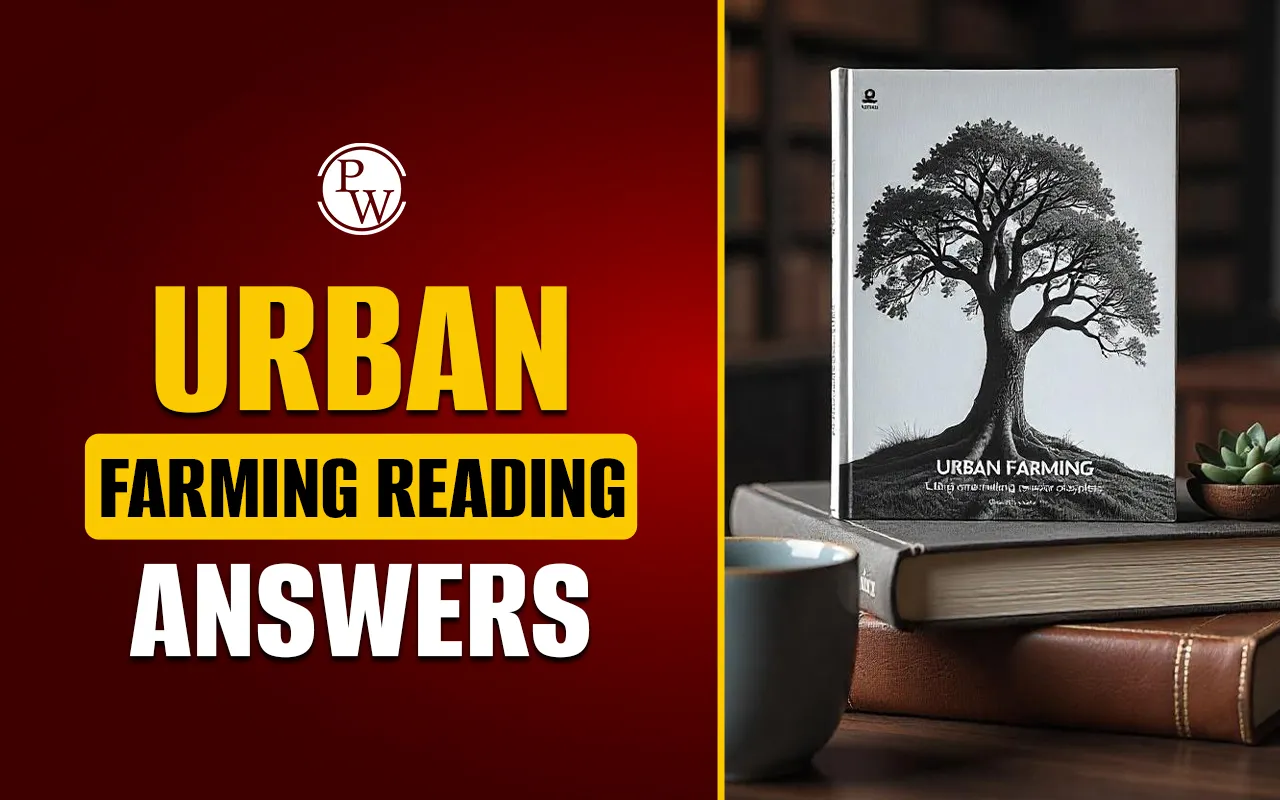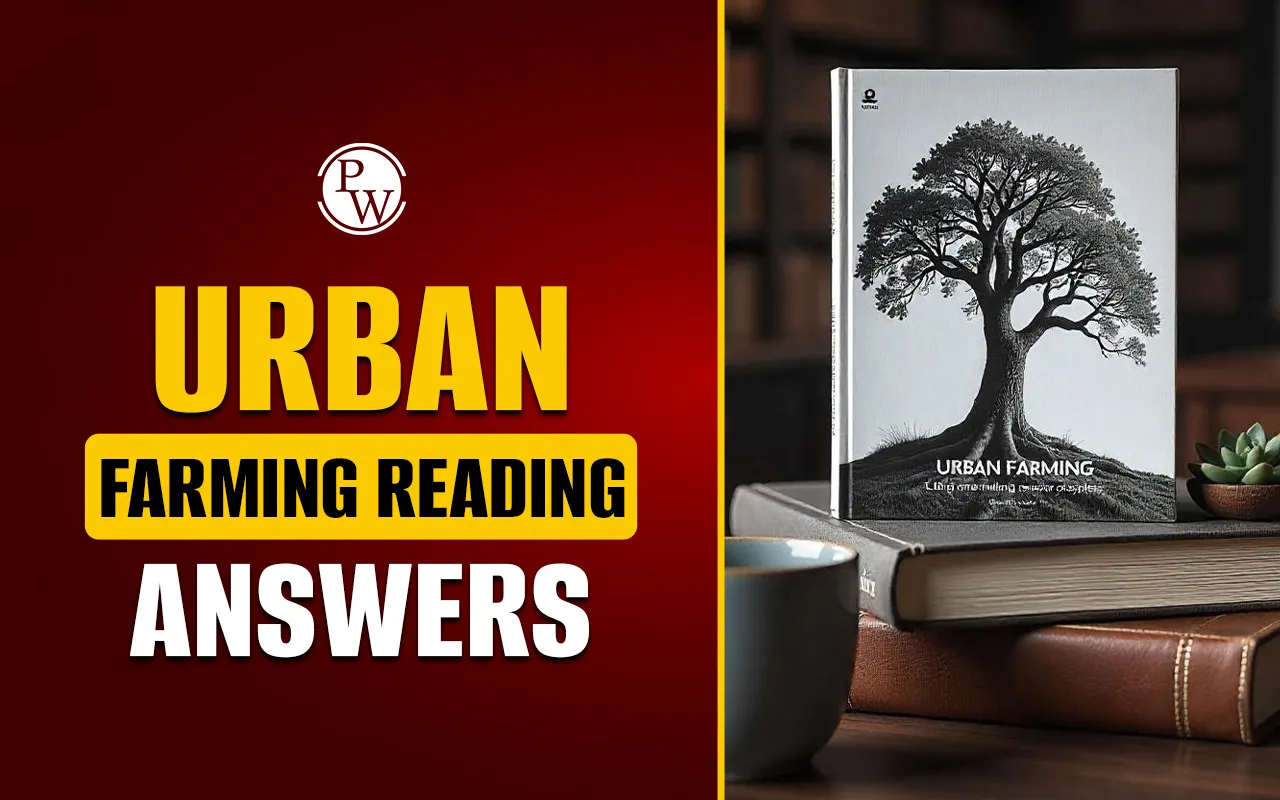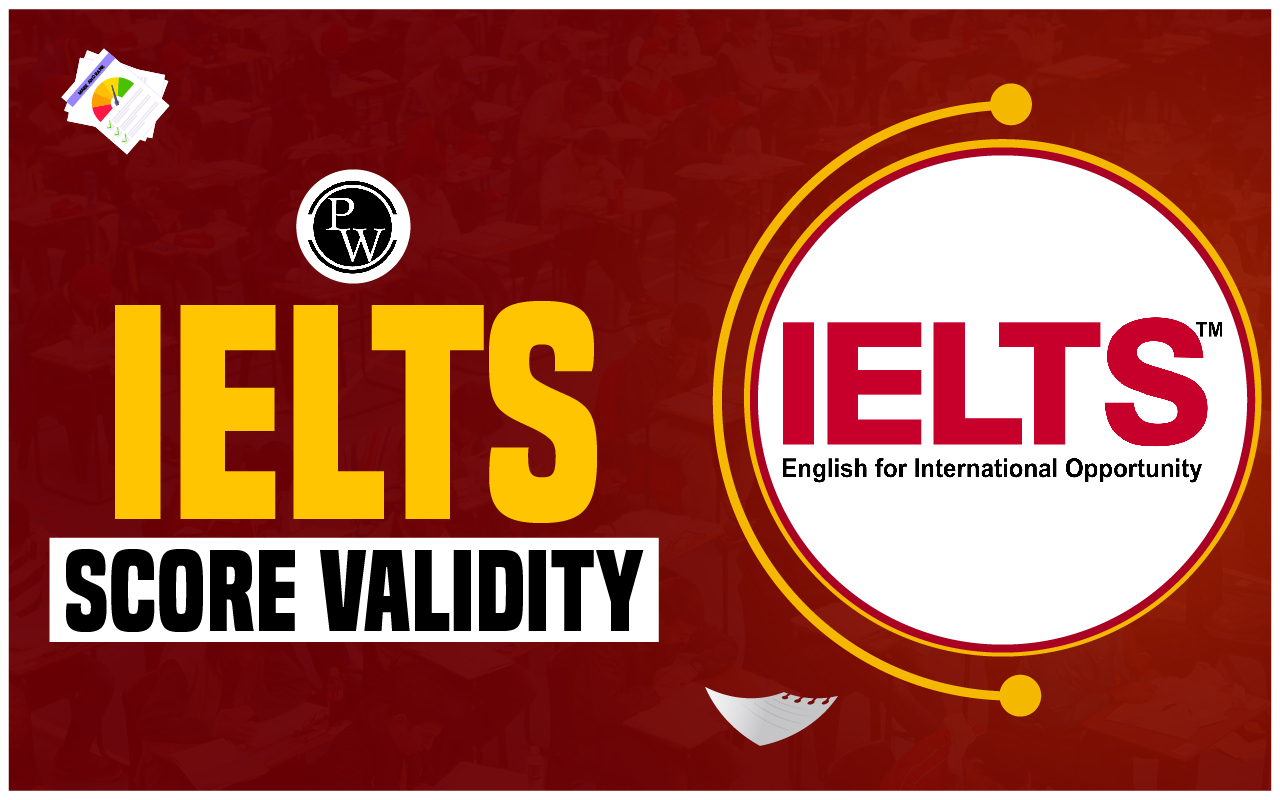

Urban Farming Reading Answers: The Urban Farming Reading Answers passage explores the concept of modern urban agriculture and its impact on food production in cities. It discusses innovative soil-free farming techniques, their benefits, and the challenges involved. This passage includes Sentence Completion, Table Completion, and True/False/Not Given questions, which will help you practice key IELTS reading skills like understanding main ideas, locating specific details, and identifying factual accuracy.
In this guide, we have provided 14 IELTS Reading questions based on the Urban Farming passage. Practicing these questions will enhance your comprehension skills and boost your IELTS Reading band score.
Urban Farming Reading Answers Passage
You should spend about 20 minutes on Questions 1-13 which are based on the Reading Passage below.
Urban Farming
Paragraph A: In Paris, urban farmers are trying a soil-free approach to agriculture that uses less space and fewer resources. Could it help cities face the threats to our food supplies?
Paragraph B: On top of a striking new exhibition hall in southern Paris, the world’s largest urban rooftop farm has started to bear fruit. Strawberries that are small, intensely flavoured and resplendently red sprout abundantly from large plastic tubes. Peer inside and you see the tubes are completely hollow, the roots of dozens of strawberry plants dangling down inside them. From identical vertical tubes nearby burst row upon row of lettuces; near those are aromatic herbs, such as basil, sage and peppermint. Opposite, in narrow, horizontal trays packed not with soil but with coconut fibre, grow cherry tomatoes, shiny aubergines and brightly coloured chards.
Paragraph C: Pascal Hardy, an engineer and sustainable development consultant, began experimenting with vertical farming and aeroponic growing towers- as the soil-free plastic tubes are known – on his Paris apartment block roof five years ago. The urban rooftop space above the exhibition hall is somewhat bigger: 14,000 square metres and almost exactly the size of a couple of football pitches. Already, the team of young urban farmers who tend it have picked, in one day, 3,000 lettuces and 150 punnets of strawberries. When the remaining two thirds of the vast open area are in production, 20 staff will harvest up to 1,000 kg of perhaps 35 different varieties of fruit and vegetables, every day. ‘We’re not ever, obviously, going to feed the whole city this way,’ cautions Hardy. ‘In the urban environment you’re working with very significant practical constraints, clearly, on what you can do and where. But if enough unused space can be developed like this, there’s no reason why you shouldn’t eventually target maybe between 5% and 10% of consumption.’
Paragraph D: Perhaps most significantly, however, this is a real-life showcase for the work of Hardy’s flourishing urban agriculture consultancy, Agripolis, which is currently fielding enquiries from around the world to design, build and equip a new breed of soil-free inner-city farm. ‘The method’s advantages are many,’ he says. ‘First, I don’t much like the fact that most of the fruit and vegetables we eat have been treated with something like 17 different pesticides, or that the intensive farming techniques that produced them are such huge generators of greenhouse gasses. I don’t much like the fact, either, that they’ve traveled an average of 2,000 refrigerated kilometers to my plate, that their quality is so poor, because the varieties are selected for their capacity to withstand such substantial journeys, or that 80% of the price I pay goes to wholesalers and transport companies, not the producers.’
Paragraph E: Produce grown using this soil-free method, on the other hand- which relies solely on a small quantity of water, enriched with organic nutrients, pumped around a closed circuit of pipes, towers and trays- is ‘produced up here, and sold locally, just down there. It barely travels at all,’ Hardy says. ‘You can select crop varieties for their flavour, not their resistance to the transport and storage chain, and you can pick them when they’re really at their best, and not before.’ No soil is exhausted, and the water that gently showers the plants’ roots every 12 minutes is recycled, so the method uses 90% less water than a classic intensive farm for the same yield.
Paragraph F: Urban farming is not, of course, a new phenomenon. Inner-city agriculture is booming from Shanghai to Detroit and Tokyo to Bangkok. Strawberries are being grown in disused shipping containers, mushrooms in underground carparks. Aeroponic farming, he says, is ‘virtuous’. The equipment weighs little, can be installed on almost any flat surface and is cheap to buy: roughly 100 to 150 per square metre. It is cheap to run, too, consuming a tiny fraction of the electricity used by some techniques.
Paragraph G: Produce grown this way typically sells at prices that, while generally higher than those of classic intensive agriculture, are lower than soil-based organic growers. There are limits to what farmers can grow this way, of course, and much of the produce is suited to the summer months. ‘Root vegetables we cannot do, at least not yet,’ he says. ‘Radishes are OK, but carrots, potatoes, that kind of thing- the roots are simply too long. Fruit trees are obviously not an option. And beans tend to take up a lot of space for not much return.’ Nevertheless, urban farming of the kind being practised in Paris is one part of a bigger and fast-changing picture that is bringing food production closer to our lives.
| IELTS Exam Important Links | |
|---|---|
| IELTS Reading Band Score | IELTS Listening Band Score |
| IELTS Speaking Band Score | IELTS Writing Band Score |
Urban Farming Reading Answers Sample Questions
Sentence Completion (Q. 1-3)
Complete the sentences below using NO MORE THAN THREE WORDS from the passage.
-
The world’s largest urban rooftop farm is located on top of a __________ in southern Paris.
-
The plastic tubes used for growing strawberries are __________, allowing the roots to dangle inside.
-
The soil-free farming method uses 90% less __________ compared to traditional intensive farming.
Table Completion (Q. 4-7)
Complete the table below using NO MORE THAN TWO WORDS from the passage.
|
Feature of Soil-Free Farming |
Details |
|
Growing Medium |
(4) __________ |
|
Water Usage |
Uses (5) __________ than conventional farming |
|
Pesticide Use |
Avoids using (6) __________ pesticides |
|
Installation Cost |
Costs approximately (7) __________ per square metre |
True/False/Not Given (Q. 8-13)
Write TRUE if the statement agrees with the information in the passage, FALSE if the statement contradicts the information, and NOT GIVEN if there is no information on this.
-
Hardy started his experiments with aeroponic farming in a greenhouse in Paris.
-
The rooftop farm in Paris is expected to produce up to 1,000 kg of fruit and vegetables daily when fully operational.
-
Hardy’s urban farming technique can completely replace traditional farming methods in cities.
-
The soil-free farming method requires artificial lighting to grow crops successfully.
-
Crops grown using aeroponic farming travel long distances before reaching customers.
-
Aeroponic farming produces vegetables that have better flavor compared to those grown conventionally.
Urban Farming Reading Answers with Explanations
Sentence Completion (Q. 1-3) Answers
|
Question |
Answer |
Location in Passage |
Explanation |
|---|---|---|---|
|
1 |
exhibition hall |
Paragraph 2: "On top of a striking new exhibition hall in southern Paris, the world’s largest urban rooftop farm has started to bear fruit." |
The passage clearly states that the urban rooftop farm is located on top of an exhibition hall. |
|
2 |
completely hollow |
Paragraph 2: "Peer inside and you see the tubes are completely hollow, the roots of dozens of strawberry plants dangling down inside them." |
The passage describes the plastic tubes as "completely hollow," confirming the answer. |
|
3 |
water |
Paragraph 6: "The water that gently showers the plants’ roots every 12 minutes is recycled, so the method uses 90% less water than a classic intensive farm for the same yield." |
The passage mentions that this method uses "90% less water," confirming the answer. |
Table Completion (Q. 4-7) Answers
|
Question |
Answer |
Location in Passage |
Explanation |
|---|---|---|---|
|
4 |
coconut fibre |
Paragraph 2: "...in narrow, horizontal trays packed not with soil but with coconut fibre..." |
The passage specifies that coconut fibre is used instead of soil. |
|
5 |
90% less |
Paragraph 6: "The water that gently showers the plants’ roots every 12 minutes is recycled, so the method uses 90% less water than a classic intensive farm for the same yield." |
The passage states that this farming method consumes 90% less water. |
|
6 |
17 different |
Paragraph 4: "First, I don’t much like the fact that most of the fruit and vegetables we eat have been treated with something like 17 different pesticides..." |
The passage mentions that conventional produce is treated with "17 different pesticides," which soil-free farming avoids. |
|
7 |
100 to 150 |
Paragraph 7: "The equipment weighs little, can be installed on almost any flat surface and is cheap to buy: roughly 100 to 150 per square metre." |
The passage provides an installation cost of "100 to 150 per square metre." |
True/False/Not Given (Q. 8-13) Answers
|
Question |
Answer |
Location in Passage |
Explanation |
|
8 |
FALSE |
Paragraph 3: "Pascal Hardy, an engineer and sustainable development consultant, began experimenting with vertical farming and aeroponic growing towers... on his Paris apartment block roof five years ago." |
The passage states that Hardy started experimenting on his apartment block roof, not in a greenhouse. |
|
9 |
TRUE |
Paragraph 3: "When the remaining two-thirds of the vast open area are in production, 20 staff will harvest up to 1,000 kg of perhaps 35 different varieties of fruit and vegetables, every day." |
The passage confirms the expected yield of 1,000 kg per day. |
|
10 |
FALSE |
Paragraph 3: "We’re not ever, obviously, going to feed the whole city this way." |
The passage explicitly states that this method cannot fully replace traditional farming. |
|
11 |
NOT GIVEN |
No mention in the passage. |
The passage discusses water recycling and minimal electricity usage but does not mention artificial lighting. |
|
12 |
FALSE |
Paragraph 5: "Produce grown using this soil-free method... is ‘produced up here, and sold locally, just down there. It barely travels at all,’ Hardy says." |
The passage states that the produce is sold locally and does not travel long distances. |
|
13 |
TRUE |
Paragraph 5: "You can select crop varieties for their flavour, not their resistance to the transport and storage chain..." |
The passage explains that aeroponic farming allows farmers to prioritize flavor over durability. |
Also Read:
- Should You Use All Capital Letters in the IELTS Listening and Reading Tests
- IELTS Reading Mistakes
- How to Improve IELTS Reading Score
- How to Manage Time in IELTS Reading
Guidance of PW IELTS
Physics Wallah offers multiple online IELTS courses for all students. Follow the IELTS pages to better prepare for the exam.
| What is IELTS Exam? | Documents Required for IELTS Registration |
| IELTS exam eligibility requirements | IELTS Exam Fees |
| IELTS test results | IELTS Exam Pattern |
Urban Farming Reading Answers FAQs
What is urban farming, and how does it work?
What are the benefits of urban farming?
Can urban farming completely replace traditional agriculture?
How does urban farming impact the environment?
What types of crops can be grown using urban farming methods?












